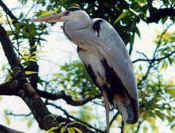Grey Heron(Ardea cinerea)
Habitat: sand banks along the coasts, river mouths, inner rivers, lakes, reservoirs, marsh land and water fields.
Feeding habits: stand in water quietly and wait to catch its prey.
Food: fish, shrimps, frogs and crabs.
Size: large-sized wading bird with a full length of 1m; weight: 1300-1900 g.
Habits: migrant bird or local resident bird. It acts alone mostly and can stand in shallow water for quite a long time. When small fish comes near, it will catch it. Thus, it is commonly called "heron"(means wait and catch). When grey heron catches a larger fish, it will first throw and knock the fish flat on the bank then swallow it up. When it eats the fish, it always puts the head of the fish into its mouth first to prevent from being hurt by the fins. It will vomit the things that are not digested. When it flies, its neck will change into the shape of "S", it will extract its long legs and then flutter its wings. It often utters sounds like "wa, wa" during flying at dusk. During the period of pregnancy, some ribbon-like feather decoration will grow on its head. Grey heron build their nests in trees in groups. They are migrant birds in most places of China and they spend winter in Southeast and Southwest China.
Category: Ave, Ciconiformes, Ardeidae
Distribution: All over Yunnan, other places of China except Qinghai-Tibet Plateau.
 
|